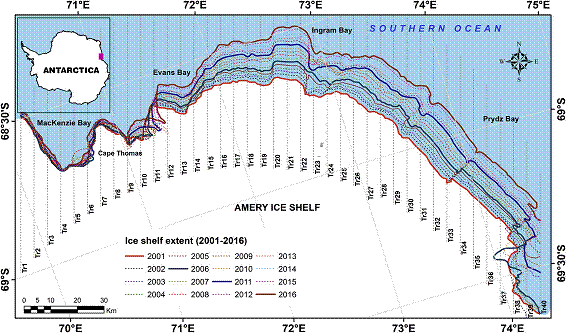Major Impact on climate due to extension of Amery Ice Shelf (AIS), NCPOR study reveals
New Delhi: The National Centre for Polar and Ocean Research (NCPOR) predicts that there would be a 24% increase in the expansion of Ameri Ice Shelf (AIS) boundaries by 2021 and another 24% expansion by 2026 from its 2016 positions. The prediction made by NCPOR is based on a 16-year-long satellite-based observation that covered an area of 60,000 sq. km across the AIS. Scientists feel that this study would help understand the ongoing changes in the ocean and atmospheric forces better.
The floating sheets of ice called the ice shelves play a multi-faceted role in maintaining the stability of a glacier. Ice shelves connect a glacier to the landmass. The ice sheet mass balance, sea stratification, and bottom water formation are important parameters for the balancing of a glacier. Latent and sensible heat processes do play important roles here.
The AIS is one of the largest glacier drainage basins in the world, located on the east coast of Antarctica, at about 70ºS Latitude, 70ºE Longitude. The AIS dynamics and mass balance help in understanding the changes in the global climate scenario.
Study area map showing the AIS extent positions from 2001 to 2016.
The insulation of ice shelves from atmospheric forcing is dependent on a temperature gradient that the ocean cavity beneath the ice shelves provides. It is the pressure exerted by the ice shelves upon the ocean cavity that determines this temperature gradient.
There is always a stress on the sea ice and ice sheets itself plays an indirect role in reducing the amplitude of the ocean swell. This is assisted by the freezing atmospheric temperature, which is capable of promoting a change in the morphology of ice shelves.
NCPOR carried out this study based on the satellite data collected from 2001 to 2016. The data were collected during the austral (relating to the southern hemisphere) summer months of January to March to understand the advancement of AIS extension and the influence of ocean atmospheric forcing in East Antarctica. The NCOPOR scientists observed a spatio-temporal change in the ice shelf as reflected by the extension of the Pridze and Mackenzie and the extension of a 200-km stretch between Mackenzie Bay (68.5ºS Latitude; 70.2ºE Longitude) and the Sandefjord Bay (69.65ºS Latitude; 74.3ºE Longitude), which is a part of the AIS.
It becomes clear from the study that the AIS is losing its stability owing to the impact of a downstream giant glacial drainage system over the past 19 years, thereby advancing the ice shelf boundaries due to higher freezing rates than basal melting.
NCPOR has also estimated the rate at which ice shelves have extended for the last three years (2017-2019). The AIS extended by about 550 m in 2017, 1470 m in 2018, and 2200 m in 2019. If this continues, it is entirely possible that in the next six years (2021 to 2026), the positions of the ice shelf would closely coincide with the actual boundary conditions.
NCPOR observations also revealed a critical cooling of the sea surface temperature (SST), resulting in an advancement of the ice shelf by 88% in the past 15 years. These changes would contribute in a major way to climate variability.
Referring to the NCPOR study from 2001 to 2016, Dr. Avinash Kumar, a senior scientist at NCPOR who is involved in the research, said: “In the background of the global warming scenario, the study reveals that the advancement in the predicted ice shelf extent closely corresponds with the actual extent. The study clearly demonstrated the application of satellite observations and statistical techniques methods for the determination and validation; the reconstruction of the past; and the prediction of the future dynamism of ocean heat fluctuation and Antarctic Amery ice shelf mass shifting-extent. These are some of the groundbreaking methods crucial for monitoring and quantification of climate change effects and its consequences. The methods could be replicated elsewhere as they are necessary for the understanding of the response of global climate change, its monitoring for sustainable environmental management.”
Led by Dr. Avinash Kumar, the research team comprised Juhi Yadav and Rahul Mohan of NCPOR, Ministry of Earth Sciences, Goa, and Aakriti Srivastava of the Department of Earth Science, Barkatullah University, Bhopal. The research paper has been published in the Journal of Environmental Management.

